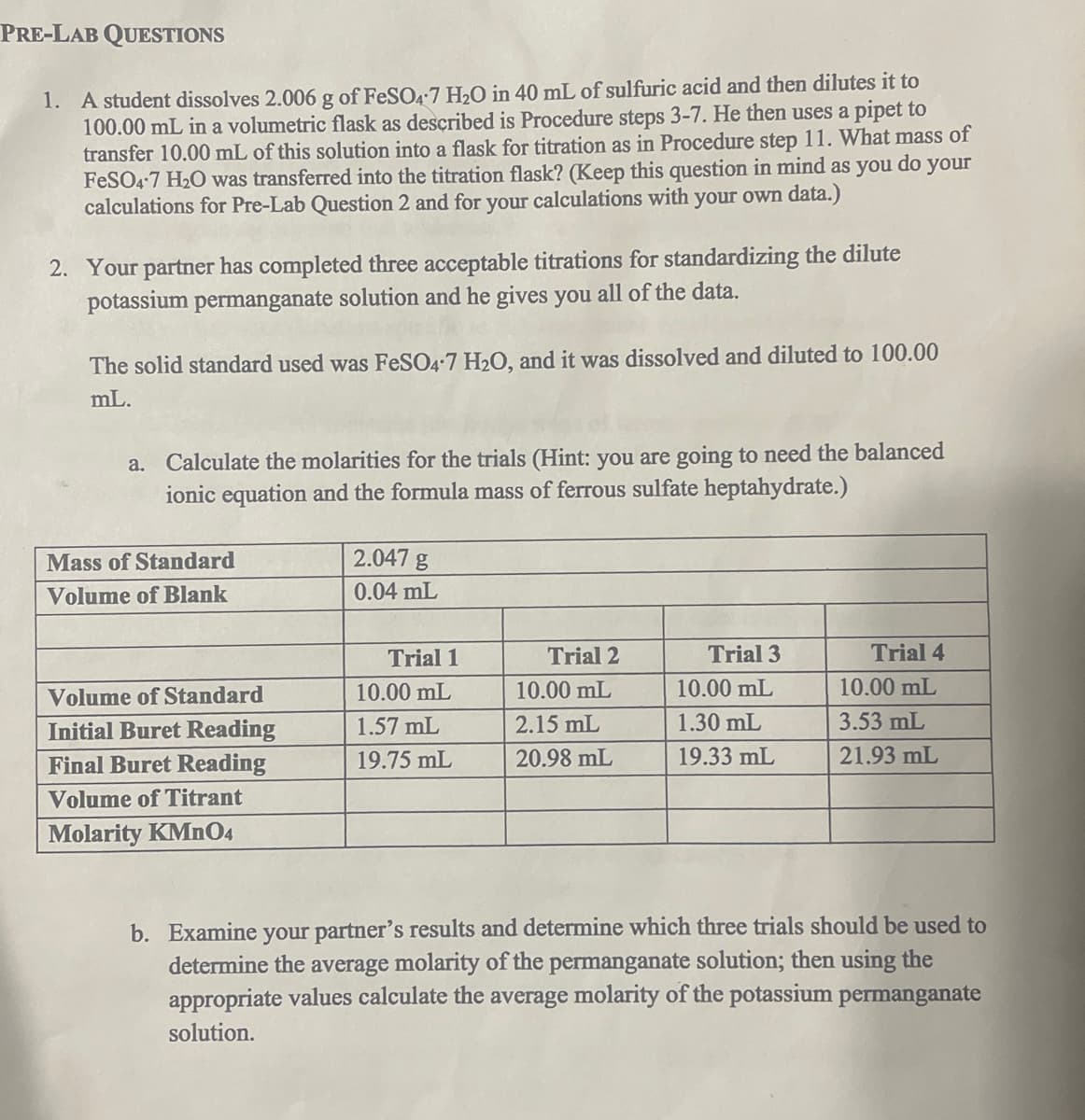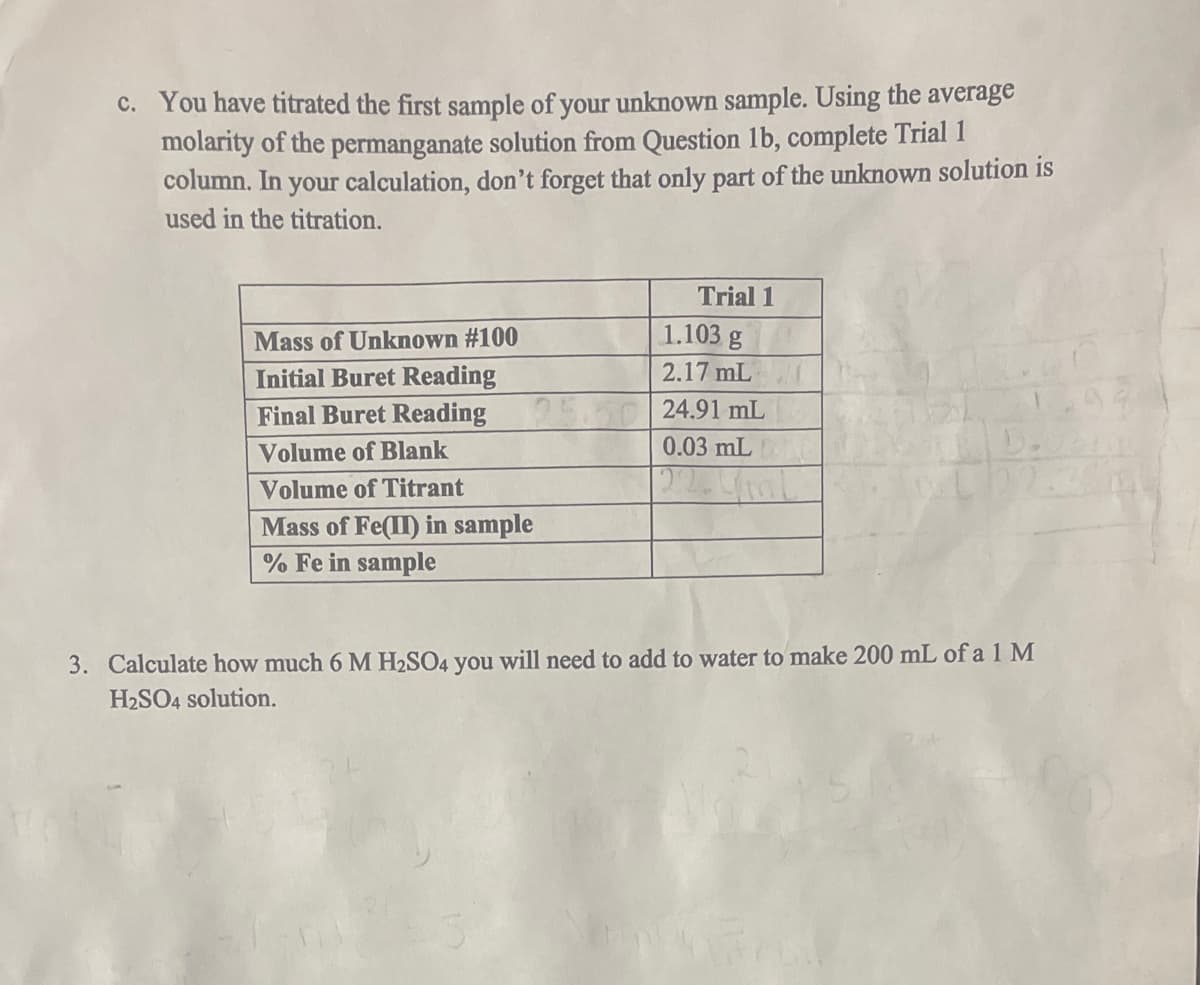1. A student dissolves 2.006 g of FeSO4 7 H₂O in 40 mL of sulfuric acid and then dilutes it to 100.00 mL in a volumetric flask as described is Procedure steps 3-7. He then uses a pipet to transfer 10.00 mL of this solution into a flask for titration as in Procedure step 11. What mass of FeSO4-7 H₂O was transferred into the titration flask? (Keep this question in mind as you do your calculations for Pre-Lab Question 2 and for your calculations with your own data.) 2. Your partner has completed three acceptable titrations for standardizing the dilute potassium permanganate solution and he gives you all of the data. The solid standard used was FeSO4-7 H₂O, and it was dissolved and diluted to 100.00 mL. a. Calculate the molarities for the trials (Hint: you are going to need the balanced ionic equation and the formula mass of ferrous sulfate heptahydrate.) Mass of Standard Volume of Blank Volume of Standard Initial Buret Reading Final Buret Reading Volume of Titrant Molarity KMnO4 2.047 g 0.04 mL Trial 1 10.00 mL 1.57 mL 19.75 mL Trial 2 10.00 mL 2.15 mL 20.98 mL Trial 3 10.00 mL 1.30 mL 19.33 mL Trial 4 10.00 mL 3.53 mL 21.93 mL b. Examine your partner's results and determine which three trials should be used to determine the average molarity of the permanganate solution; then using the appropriate values calculate the average molarity of the potassium permanganate solution.
1. A student dissolves 2.006 g of FeSO4 7 H₂O in 40 mL of sulfuric acid and then dilutes it to 100.00 mL in a volumetric flask as described is Procedure steps 3-7. He then uses a pipet to transfer 10.00 mL of this solution into a flask for titration as in Procedure step 11. What mass of FeSO4-7 H₂O was transferred into the titration flask? (Keep this question in mind as you do your calculations for Pre-Lab Question 2 and for your calculations with your own data.) 2. Your partner has completed three acceptable titrations for standardizing the dilute potassium permanganate solution and he gives you all of the data. The solid standard used was FeSO4-7 H₂O, and it was dissolved and diluted to 100.00 mL. a. Calculate the molarities for the trials (Hint: you are going to need the balanced ionic equation and the formula mass of ferrous sulfate heptahydrate.) Mass of Standard Volume of Blank Volume of Standard Initial Buret Reading Final Buret Reading Volume of Titrant Molarity KMnO4 2.047 g 0.04 mL Trial 1 10.00 mL 1.57 mL 19.75 mL Trial 2 10.00 mL 2.15 mL 20.98 mL Trial 3 10.00 mL 1.30 mL 19.33 mL Trial 4 10.00 mL 3.53 mL 21.93 mL b. Examine your partner's results and determine which three trials should be used to determine the average molarity of the permanganate solution; then using the appropriate values calculate the average molarity of the potassium permanganate solution.
Chemistry
10th Edition
ISBN:9781305957404
Author:Steven S. Zumdahl, Susan A. Zumdahl, Donald J. DeCoste
Publisher:Steven S. Zumdahl, Susan A. Zumdahl, Donald J. DeCoste
Chapter1: Chemical Foundations
Section: Chapter Questions
Problem 1RQ: Define and explain the differences between the following terms. a. law and theory b. theory and...
Related questions
Question

Transcribed Image Text:PRE-LAB QUESTIONS
1. A student dissolves 2.006 g of FeSO4-7 H₂O in 40 mL of sulfuric acid and then dilutes it to
100.00 mL in a volumetric flask as described is Procedure steps 3-7. He then uses a pipet to
transfer 10.00 mL of this solution into a flask for titration as in Procedure step 11. What mass of
FeSO4-7 H₂O was transferred into the titration flask? (Keep this question in mind as you do your
calculations for Pre-Lab Question 2 and for your calculations with your own data.)
2. Your partner has completed three acceptable titrations for standardizing the dilute
potassium permanganate solution and he gives you all of the data.
The solid standard used was FeSO4-7 H₂O, and it was dissolved and diluted to 100.00
mL.
a. Calculate the molarities for the trials (Hint: you are going to need the balanced
ionic equation and the formula mass of ferrous sulfate heptahydrate.)
Mass of Standard
Volume of Blank
Volume of Standard
Initial Buret Reading
Final Buret Reading
Volume of Titrant
Molarity KMnO4
2.047 g
0.04 mL
Trial 1
10.00 mL
1.57 mL
19.75 mL
Trial 2
10.00 mL
2.15 mL
20.98 mL
Trial 3
10.00 mL
1.30 mL
19.33 mL
Trial 4
10.00 mL
3.53 mL
21.93 mL
b. Examine your partner's results and determine which three trials should be used to
determine the average molarity of the permanganate solution; then using the
appropriate values calculate the average molarity of the potassium permanganate
solution.

Transcribed Image Text:c. You have titrated the first sample of your unknown sample. Using the average
molarity of the permanganate solution from Question 1b, complete Trial 1
column. In your calculation, don't forget that only part of the unknown solution is
used in the titration.
Mass of Unknown #100
Initial Buret Reading
Final Buret Reading
Volume of Blank
Volume of Titrant
Mass of Fe(II) in sample
% Fe in sample
Trial 1
1.103 g
2.17 mL
24.91 mL
0.03 mL
3. Calculate how much 6 M H₂SO4 you will need to add to water to make 200 mL of a 1 M
H₂SO4 solution.
Expert Solution
This question has been solved!
Explore an expertly crafted, step-by-step solution for a thorough understanding of key concepts.
This is a popular solution!
Trending now
This is a popular solution!
Step by step
Solved in 2 steps

Knowledge Booster
Learn more about
Need a deep-dive on the concept behind this application? Look no further. Learn more about this topic, chemistry and related others by exploring similar questions and additional content below.Recommended textbooks for you

Chemistry
Chemistry
ISBN:
9781305957404
Author:
Steven S. Zumdahl, Susan A. Zumdahl, Donald J. DeCoste
Publisher:
Cengage Learning

Chemistry
Chemistry
ISBN:
9781259911156
Author:
Raymond Chang Dr., Jason Overby Professor
Publisher:
McGraw-Hill Education

Principles of Instrumental Analysis
Chemistry
ISBN:
9781305577213
Author:
Douglas A. Skoog, F. James Holler, Stanley R. Crouch
Publisher:
Cengage Learning

Chemistry
Chemistry
ISBN:
9781305957404
Author:
Steven S. Zumdahl, Susan A. Zumdahl, Donald J. DeCoste
Publisher:
Cengage Learning

Chemistry
Chemistry
ISBN:
9781259911156
Author:
Raymond Chang Dr., Jason Overby Professor
Publisher:
McGraw-Hill Education

Principles of Instrumental Analysis
Chemistry
ISBN:
9781305577213
Author:
Douglas A. Skoog, F. James Holler, Stanley R. Crouch
Publisher:
Cengage Learning

Organic Chemistry
Chemistry
ISBN:
9780078021558
Author:
Janice Gorzynski Smith Dr.
Publisher:
McGraw-Hill Education

Chemistry: Principles and Reactions
Chemistry
ISBN:
9781305079373
Author:
William L. Masterton, Cecile N. Hurley
Publisher:
Cengage Learning

Elementary Principles of Chemical Processes, Bind…
Chemistry
ISBN:
9781118431221
Author:
Richard M. Felder, Ronald W. Rousseau, Lisa G. Bullard
Publisher:
WILEY